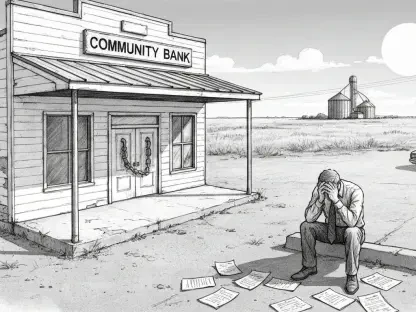In a landscape where financial disparities continue to challenge many New Yorkers, Governor Kathy Hochul has emerged as a steadfast advocate for economic equity, spearheading initiatives that prioritize underserved communities often sidelined by traditional banking systems. Across the state, countless individuals and small businesses struggle to access affordable credit and financial services, a gap that deepens inequality in both urban and rural areas. Hochul’s recent efforts, supported by innovative guidance from the New York State Department of Financial Services (DFS), are designed to bridge this divide, ensuring that every resident, regardless of their zip code or income level, can tap into the tools needed for financial stability. By focusing on Community Development Financial Institutions (CDFIs) and Minority Depository Institutions (MDIs), the state is not just addressing immediate needs but also laying a foundation for long-term prosperity, setting a powerful example amid fluctuating federal support.
State Leadership in Financial Equity
Protecting CDFIs Amid Federal Uncertainty
Governor Hochul’s administration is taking a firm stand against federal policies that threaten to undermine the vital work of CDFIs, which are instrumental in delivering financial services to marginalized populations across New York. With over 80 certified CDFIs in operation, these institutions face potential certification lapses due to federal budget cuts and reduced support, a concern that could disrupt their ability to secure investments. The state’s response, through new DFS guidance, ensures that state-chartered banks can still receive Community Reinvestment Act (CRA) credit for supporting CDFIs, even if federal certifications falter for reasons unrelated to their mission. This protective measure secures a steady flow of capital into communities that rely on these organizations for affordable housing loans and small business funding, demonstrating a commitment to safeguarding local economies against national policy uncertainties.
Beyond merely shielding CDFIs from federal setbacks, Hochul’s approach signals a broader intent to redefine financial inclusion on the state’s terms, prioritizing the needs of New York’s most vulnerable residents. This policy not only preserves existing investments but also encourages banks to continue partnering with CDFIs, knowing their contributions will be recognized under state regulations. Such a move is particularly critical for underserved neighborhoods where traditional banks often hesitate to operate, leaving a void that CDFIs fill with tailored financial solutions. By addressing this federal-state disconnect, New York is ensuring that economic development in minority and low-income areas does not stall, reinforcing the role of these institutions as lifelines for communities striving to overcome systemic barriers to financial access.
Contrasting State and Federal Approaches
While federal support for community-based financial institutions appears to wane under political pressures, New York’s leadership under Hochul stands out as a beacon of proactive governance aimed at empowering local economies. Republican-led efforts in Washington to slash funding for CDFIs have drawn sharp criticism from state officials, who argue that such cuts jeopardize the very mechanisms that drive equity in underserved areas. In contrast, New York’s policies, as articulated by DFS Superintendent Adrienne A. Harris, focus on strengthening these institutions as frontline agents of economic growth, employment, and wealth-building. This stark difference highlights a state-driven resolve to counteract national neglect with tangible, community-focused solutions.
This contrast between state initiative and federal retreat is more than a policy disagreement; it reflects a fundamental divergence in priorities that directly impacts New Yorkers seeking financial stability. Where federal actions risk destabilizing CDFIs and MDIs, New York’s framework offers a safety net, ensuring that these entities can continue their mission without interruption. Legislative voices across the state have echoed Hochul’s stance, emphasizing that local empowerment must take precedence over partisan gridlock at the national level. By positioning itself as a counterforce to federal inaction, New York not only protects its most vulnerable populations but also sets a precedent for other states to follow in the pursuit of economic justice.
Financial Investments and Tangible Impact
Major Funding for Community Programs
New York’s commitment to financial inclusion extends beyond policy protections to include substantial monetary investments through Empire State Development (ESD) programs, targeting the core needs of unbanked and underbanked communities. Over the past five years, nearly $18 million in grants have been directed to CDFIs, complemented by a hefty $500 million in federal funding via the State Small Business Credit Initiative. These resources are strategically allocated to establish capital access and equity programs, ensuring that small businesses, microbusinesses, and individuals without traditional banking relationships can secure affordable credit. This financial backing underscores a long-term vision for economic empowerment, directly addressing the systemic barriers that hinder financial progress in marginalized areas.
The scope of these investments reveals a deliberate effort to transform financial landscapes across the state, particularly for those who have historically been excluded from mainstream economic opportunities. Programs supported by ESD funding are designed to provide not just capital but also technical assistance, helping recipients navigate the complexities of financial systems. This dual approach—combining monetary support with educational resources—amplifies the impact of each dollar invested, fostering sustainable growth in communities that desperately need it. As a result, thousands of New Yorkers are gaining access to tools that pave the way for entrepreneurship, homeownership, and personal financial security, marking a significant step toward reducing economic disparities.
Real-World Benefits for New Yorkers
The tangible outcomes of Hochul’s initiatives are becoming increasingly visible in communities revitalized by programs like the Small Business Revolving Loan Fund 2.0, which has allocated $35.5 million to CDFI partners. These funds are fueling local economies by supporting small businesses that often struggle to secure loans from conventional banks due to stringent criteria or lack of collateral. The ripple effects are profound, with increased access to credit enabling entrepreneurs to hire employees, expand operations, and contribute to the economic vitality of their neighborhoods. From urban centers to rural towns, this infusion of capital is helping to close the wealth gap and build a more inclusive financial ecosystem.
Equally impactful is the Contractor Financing Program, which has directed $18.2 million through CDFI partners to bolster businesses in need of working capital for projects. This initiative, alongside others, directly benefits underbanked individuals by offering pathways to financial stability that were previously out of reach. Beyond mere numbers, the real success lies in the stories of New Yorkers who can now afford homes, start businesses, or access emergency funds without falling prey to predatory lenders. These programs are not just about immediate relief but about creating lasting change, ensuring that underserved populations have the resources to thrive in a competitive economic environment.
Collaboration and Community Focus
Strengthening Partnerships
A cornerstone of Governor Hochul’s strategy for financial inclusion lies in fostering robust partnerships between CDFIs, MDIs, and some of New York’s largest banks, creating a network dedicated to sustaining capital access for underserved areas. Recent convenings facilitated by the state have brought these stakeholders together to strategize on how best to support community-focused financial institutions. Such collaboration is essential for amplifying the reach of CDFIs, which often operate with limited resources compared to traditional banks. By aligning the interests of major financial players with those of local organizations, the state ensures that investments are both impactful and strategically directed to where they are needed most.
These partnerships go beyond mere dialogue, translating into actionable commitments that bolster the capacity of CDFIs and MDIs to serve their communities effectively. Banks, incentivized by CRA credit assurances, are more willing to invest in initiatives that might otherwise be deemed too risky, while CDFIs gain the financial backing to expand their programs. This synergy is critical for maintaining a steady flow of affordable credit to small businesses and individuals who lack access to conventional banking services. The collaborative model championed by Hochul’s administration serves as a blueprint for how public and private sectors can unite to address systemic inequities, driving economic growth from the ground up.
Collective Effort for Economic Growth
The collective effort among state agencies, financial institutions, and community leaders reflects a shared dedication to fostering economic growth through targeted financial inclusion initiatives. This unified approach is evident in the way ESD partners with CDFIs to distribute funds through tailored programs that address specific community needs, such as supporting small business owners or promoting homeownership. By pooling resources and expertise, stakeholders are creating a multiplier effect, where each investment yields broader benefits like job creation, increased tax revenues, and stronger local economies. This collaborative spirit ensures that no corner of New York is left behind in the push for financial equity.
Moreover, the emphasis on collective action highlights a recognition that sustainable economic progress cannot be achieved in isolation but requires the involvement of diverse players with aligned goals. State leaders have consistently stressed the importance of working together to tackle challenges like unemployment and housing affordability, which disproportionately affect underserved populations. Through this joint endeavor, New York is not only addressing immediate financial gaps but also building a resilient framework that can withstand future economic uncertainties, ensuring that the benefits of growth are equitably shared across all communities.
Voices of Support and Regional Perspectives
Consensus Among State Leaders
A remarkable unity of purpose exists among New York’s state leaders regarding the critical role of CDFIs and MDIs in achieving economic equity, a consensus that amplifies the impact of Hochul’s initiatives. From the Governor herself to DFS Superintendent Adrienne A. Harris and ESD Commissioner Hope Knight, there is a clear agreement that supporting these institutions is non-negotiable for fostering financial inclusion. Legislative figures like Senator Charles Schumer and Assemblymember Al Stirpe have also voiced strong approval, noting how these efforts provide a lifeline to populations often excluded from mainstream financial systems. This alignment across different branches of government underscores a statewide commitment to prioritizing underserved communities.
This shared vision among leaders is not just rhetorical but is backed by coordinated policy actions and funding allocations that reflect a deep understanding of the challenges facing New York’s most vulnerable residents. The emphasis on CDFIs as engines of economic opportunity resonates in every statement, with leaders pointing to their proven track record in delivering affordable credit and support services. Such unity fosters confidence among stakeholders that the state’s approach is both strategic and sustainable, capable of delivering measurable improvements in financial access and stability for those who need it most, regardless of their background or location.
Community-Specific Impacts
Legislators and local advocates have shed light on the region-specific benefits of Hochul’s financial inclusion efforts, illustrating how CDFI funding addresses unique challenges in diverse areas of New York, from the Mohawk Valley to Buffalo. Assemblymember Marianne Buttenschon, for instance, has highlighted the transformative effect of these investments in rural communities, where access to capital can mean the difference between economic stagnation and growth. In such regions, CDFIs often serve as the only viable source of financing for small businesses and homeowners, filling a critical gap left by larger banks that may overlook smaller markets. These localized impacts demonstrate the adaptability of state programs to meet varied needs.
Urban areas, too, reap significant rewards from these initiatives, as noted by Assemblymember Clyde Vanel, who points to the stabilizing effect of CDFI support on local economies in densely populated neighborhoods. Here, funding helps combat issues like housing unaffordability and limited business opportunities, directly benefiting minority and low-income residents. The regional perspectives offered by legislators reveal a comprehensive picture of how Hochul’s policies resonate across New York’s diverse landscape, ensuring that whether in a bustling city or a quiet rural town, communities have the financial tools to build brighter futures and contribute to the state’s overall economic vitality.









